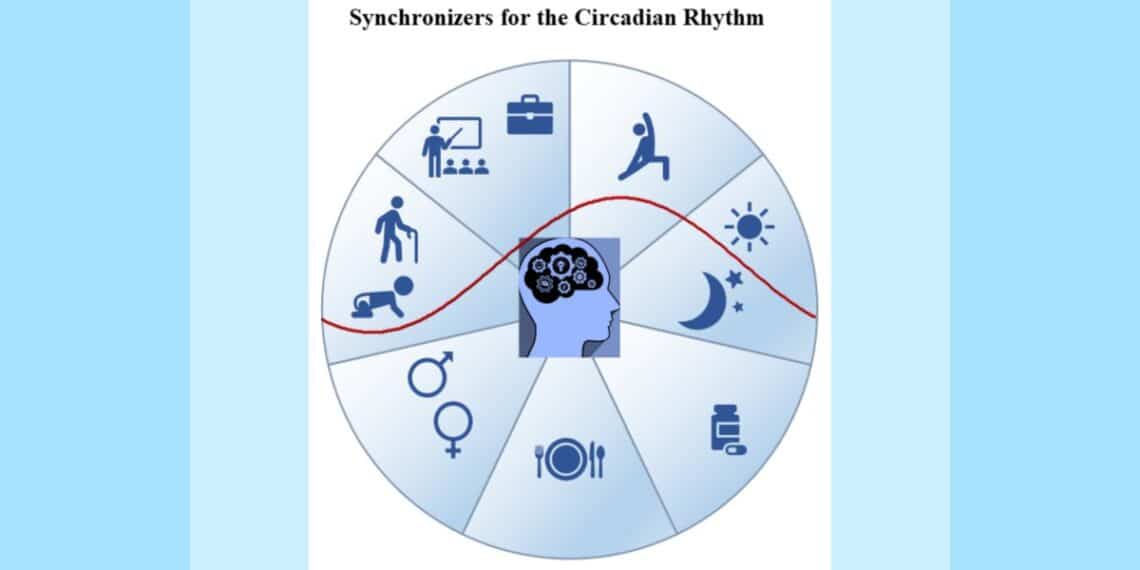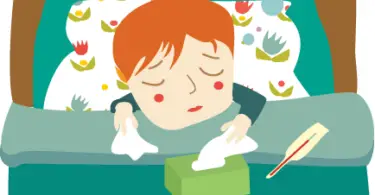ARTICLE
1)INTRODUCTION :
a) What is a Rhythm ?
– Chronobiology : science that studies Biological Rhythms.
– Cycle : Pattern that repeats itself continually. Each one of the specific recurring events that happen with a determined periodicity.
– Frequency : Number of cycles that happen in a certain time. Number of successions of a certain kind of event per time unit.
– Period : Duration of a complete rhythmic cycle. Time that a wave requires to complete a cycle, and go back to the starting point. Interval between 2 cycles.
– Photoperiodicity : Response of a certain organism to the relative duration of day and night.
b) Some Examples in Plants and Animals :
1. In plants, the leaves “rise” at the beginning of the day, and go “down” as the sun sets .
The Heliotrope rotates its stem so that its branches and leaves can always face the sun. In Greek mythology it was said that the Heliotrope represented the non-corresponded love of Clytie – daughter of the king of Babilony – for the sun god Helios.
Linnaeus described a Floral Clock, by which botanists could know the hour of the day, according to the moment at which the plants open their flowers. French astronomer de Mairan (1729) found that heliotropes locked in a dark closet kept moving their leaves with a 24 hrs. rhythm; proving clearly the existence of an
Internal Clock : Darwin made the same observations as de Marian, and discussed them in his book : “The Power of Movement of Plants”. Bunning described the genetic characteristic of the internal clock in the pea leaves.
2. During the Greek era, Aristotle described the swelling of sea urchin ovaries during the new moon. Also, Cicero and Pliny observed that the number of oysters and other shellfish ” increase and decrease” according to the moon´s phases.
Crustaceans collected at the coast, even within a lab., keep their “activity cycles” according to the tides. In Panama there lives the “3 hours bird” , that sings exactly at that time, either day or night.
In 1945, Mottram found that mice painted with benzypyrene, developed more tumors in the next weeks when the paint was applied at midnight, than at noon.
In Germany, Kramer (1950) found that diurnal birds guide themselves by the sun (solar compass); afterwards Sauer (1955) described that night birds use the stars as compass. Also, it has been seen that flies are more sensitive to the sprays at evening.
Annual cycles were first studied by Benoit and Assenmacher in ducks under experimental conditions of light/darkness; afterwards by Fisher and Pengelley in sparrows under hibernation.
Moore and Eichler, and afterwards Stephan and Zucker, proved in hamsters that the destruction of the suprachiasmatic nuclei produces a loss of the circadian rhythmicity in several functions.
2. FIRST RESEARCH IN HUMANS
In 1614, Italian physician Sanctorius sketched a giant balance to measure his weight. During 30 years he made the observation that it “fluctuated” with a monthly rhythm parallel to a 30 day cycle in his urine turbidity. In 1842, Gierse described for the first time that the body´s normal temperature reaches a minimum ( approx. 36.5 d. C. ) at early morning, and a maximum ( approx. 37.5 d. C. ) at night. Graffenberg, in 1893, studied the influence of light and darkness in the number of erythrocytes in blood.
At the end of the last century, Manson at London described the periodicity of the microfilaria.
In 1927, the Swedish physician Forsgreen described the periodic formation of bile and glycogen in human liver; the quantity changing with the hour of the day; and with an inverse relationship between them. In 1938, researchers Kleitman and Richardson spent 32 days in the Mammoth cave at Kentucky. In 1937, 5 physicians, 1 botanist and a zoologist created the International Society for the Biological Rhythms.
Pincus in 1943, was the first to report the normal variations that are produced in the 17-ketosteroids excretion. In 1950, Hallberg used normal and blind mice to study the cyclic changes in their temperature and leucocytes. He also proposed the term CIRCADIAN to refer to cycles approx. of 24 hrs. It was him also, who studied during 15 years, the urinary excretion of 17-ketosteroids in a healthy person, finding several rhythms: one of almost one week, another of 20 days, other near to one month, and another closer to one year ( with “downs” in May and “ups” in Autumn and Winter). Annual rhythms have also been found in the psychotic relapses and in weight changes in manic-depressive patients. The first Congress of Biological Rhythms was at Cold Spring Harbor, Florida, in 1960. In 1962, the French researcher Michel Siffre spent 2 months alone in a cave, with observations on changes in some of his rhythms. In Germany, Prof. Aschoff used arranged bunkers for studies of total isolation during 16 to 30 hours.
3. RHYTHMS AND THE NORMAL FUNCTIONS OF HUMAN BEINGS :
For their study, rhythms are divided in :
– Ultradians: less than 24 hrs. Like the cellular functions, heart beat, or brain waves.
– Circadians: Around 24 hrs. Sleep/ Awake. Changes in blood components, hormones. Body temperature.
– Infradians: More than 24 hrs. Including the Circaseptal (7 days), Circamensual (30 days), etc.
Internal (Endogenous) Rhythms are controlled by an “External Environment”, (also called External or Exogenous Cycles, Geophysical, or Periodic Environmental Factors) : day/night (light/darkness) cycle, season changes, different Earth meridians, Earth´s rotation and translation; tides (moon´s attraction), changes in atmospheric pressure, solar flares, cosmic radiation.
In mammals Internal Rhythms are controlled by the Suprachiasmatic Nucleus, which are located in the brain´s basement, at the anterior hypothalamus. From there two branches emerge, one that goes to the Hypophysis gland, which elaborates several hormones that travel to the general circulation, and regulate all the endocrine system.
Afterwards, the different hormones produced at the thyroid, suprarenal, ovaries and testes arrive through the general circulation to stimulate the Hypophysis, and so, “close the circuit” in what is known as the Hormonal Feedback. The other branch controls the functions of the Sympathetic and the Parasympathetic Systems, which are part of the Autonomous Nervous System.
Also, at the brain´s basement is the Pineal gland, which works as a mediator between the sunlight, retina, optic nerve (retino-hypothalamic path), and finally the Central/Endocrine Nervous System.
In order to develop this activity, the Pineal gland produces Melatonin, a hormone which is liberated to the general circulation, but primarily works as neurotransmitter in the Central Nervous System (mostly upon the Suprachiasmatic Nucleus), affecting the oscillatory phase of the Circadian and Reproductive Rhythms. Its secretion reaches a peak at night, between 2 and 6 a.m., this “secretory rhythm”depending upon the daylight intensity.
Among the conditions that control the Amplitude in the Melatonin´s secretion rhythm are :
a) Age
b) Kind of work (diurnal/nocturnal).
c) Menstrual cycle (melatonin´s secretion decreases during the pre-ovulatory phase).
d) Season
e) Sunlight
f) Certain drugs
g) Stress/ Exercise.
For all the previous concepts, Melatonin can be considered the Seasonal Syncronizer of the Yearly Endogenous Rhythms.
Some examples of Rhythms in the human body are: brain waves (alpha, beta, theta and delta) , cardiac rhythm (80 beats/minute) and the every day/day to day fluctuations in arterial pressure and body temperature.
4. APPLICATIONS OF RHYTHMS IN OUR DAILY LIFE :
From the point of view of Chronobiology, there are 2 kind of persons: the Early Risers and the Noctambulists. The first ones, work better in the morning, being the contrary to the others, and vice versa.
Based in all the previous concepts, it has been found that the ” worst” hour for a visit to the dentist is at 6 p.m., because the endogenous analgesic mechanisms (as for example, the endorphin production ) reaches its “minimum” around this hour. Also, the tolerance for alcohol is greater in the afternoons.
Related to nutrition, the best hour for glucose assimilation is in the mornings, so, the optimal metabolic conditions for losing weight are when the greater intake of food is done during breakfast.
On average, the Maximum Intellectual Performance is between 10 a.m. and 3 p.m.
In contrast, the Maximum Physical Performance is in the afternoon.
The greatest amount of mistakes is with night workers, and also, after lunch hours (having eaten or not). When people are flying to another meridian, their body sometimes needs one week to adapt to the new schedule (jet- lag). Actually, sleeplessness is considered an Internal Desyncronization ( the same as in Chronic Diseases) , and the remedies are called Re-synchronizers.
5. RHYTHMS AND DISEASES :
Some of the diseases that “predominate” in the
Mornings :
Chest angina, rheumatoid arthritis, stroke, myocardial infarction, depression, gout
attack, hay fever, heat flushes of the menopause, stroke, migraine, peptic ulcer, essential hypertension, allergic rhinitis and epilepsy (certain cases) .
Afternoon :
Anxiety, peptic ulcer, osteoarthritis, myocardial infarction and essential hypertension
Evening :
Anxiety, suicidal attempt, heat flushes of the menopause, myocardial infarction, osteoarthritis, atopic dermatitis.
Night :
Asthma, atopic dermatitis, biliary colic, peptic ulcer and epilepsy (certain cases) .
Monday : Myocardial infarction.
Spring : Migraine, allergic rhinitis.
Summer : Asthma.
Autumn : Arthritis, asthma, myocardial infarction, migraine.
Winter : Arthritis, depression /suicide , myocardial infarction, testicular seminoma.
Florida surgeons found that the post-tonsillectomy bleeding is “80 % greater” during the full moon (14th day).
BIBLIOGRAPHY :
1.- Ahlgreen, A, Halberg, F . Cycles of Nature. An introduction to biological rhythms
Washington, DC: National Science Teachers Assoc. 1990.
2.- Cardinali, D , Golombek, D, Bomanni, R. Relojes y Calendarios Biològicos. La sincronia del hombre con el medio ambiente. Buenos Aires: Fondo de Cultura Económica de Argentina Breviarios de Ciencia Contemporanea 1st. Ed. 1992.
3.- Cardinali, D, Jorda, J, Sánchez, E . Introducción a la CronobiologÃa . FisiologÃa de los ritmos biológicos. Cantabria : Universidad de Cantabria, España 1994.
4.- Cornelissen, G , Halberg, F , Introduction to Chronobiology. Variability : from foe to friend, of mice and men. Medtronic Chronobiology Seminar, No. 7, Minneapolis: Franz Halberg 1994.
5.- Halberg, F , Barnwell, F, Hurshesky, W. Chronobiology, a science in tune with the rhythms of life : Earl Bakken 1986.
6.- Hering, C , ” On the periodical annual recurrence of certain phenomena “. NAJH 1853, May ; reprinted at : R 1997, July/August : 26-28.
7.- Ibarra, R , ” Chronobiology, a possible explanation of homeopathic aggravation ” . BJHR 1991; vol. 1, No. 4/5. Sept./Dec. : 281-285.
8.-Ibarra, R. ” Chronobiology and the homeopathic treatment of menstrual disorders”. WHN 1994; vol. V, Issue No. 2 , Spring : 3
9.- Ibarra, R. ” Chronobiology and Homeopathy : The periodicity of chronic diseases”. TLDP .1995 ;Oct. : 130-131
10.- Ibarra, R , ” Chronobiology and Homeopathy : Periodicity of allergies and their homeopathic treatment ” WHN 1996 ; vol. 7, issue 3, summer : 3-14.
11.- Ibarra, R , ” Endometriosis and homeopathy: A chronobiological approach. TLDP 1997; April : 110-111.
12.- Ibarra, R , Biological Rhythms of Human Being. General Bibliography. 1960- 1997.
( 205 references ) Guadalajara. Raúl Ibarra 1998.
Dr. Raul Ibarra graduated with an M. D. from the University of Mexico in 1974 and postgraduated in HomeopatÃa de México, A.C. in 1977. He was a member of the Mexican Institute for Medicinal Plants ( IMEPLAM ) and Professor and Subdirector of the Homeopathic School at the Universidad del Altiplano, at Guadalajara, Jalisco during (1979.)
Dr. Ibarra was Coordinator of the botanical project : ” Flora of Oaxaca “, for the Instituto Tecnológico de Oaxaca, from 1980 to 83. He has private practices in classical homeopathy in Mexico City, Cuernavaca, Oaxaca, Ensenada, and Guadalajara.
He has done independent bibliographical research in Psychosomathic Medicine and Human Chronobiology and authored four homeopathy books pub.- Editorial Albatros, in Buenos Aires, Argentine.
His writings include:
“Groups Classification of General Modalities ” , published by Nueva Editorial Médica Homeopática Mexicana, México city, México.
Two Homeopathic Botanical articles published in the Liga Congress at Acapulco, México, and also in England.
Homeopathic Chronobiology articles published in the Berlin Journal of Homeopathic Research, the Journal of the California Homeo. Medical Society, and Townsend Letter for Doctors.
An article published at the 100 years anniversary of the American Institute of Homeopathy.
When not practicing homeopathy he is an avid tennis player, plays and teaches piano and recently wrote the book ” Piano – Método Numérico para Música Popular “






its great to read about biological rhythms,actually I was shocked that rhthyms have such different effects on our body.
Has anybody done a study on section 5, Rhythms and Disease vs the Modalities in the Repertory? It would be interesting to find out if the modalities of the remedies useful for the ailments mentioned are confirmed by the rhythms mentioned in the article…
Por favor, me urge comunicarme con el Dr.Ibarra, vivo en el Distrito Federal y hace 10 años me trato con mucho éxito de cáncer en la matriz.
Lo he recomendado mucho, pero no se donde encontrarlo, por favor díganme como me contacto con él.
Muchas gracias.
Dr Raúl Ibarra (33)-36-77-11-45